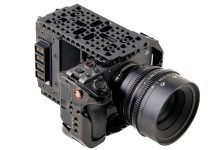Flying a drone in icy-cold weather could be much more challenging and riskier than it may initially seem. Taking off in weather conditions below the freezing point means significantly reduced flight times, shorter battery life, sudden and unforeseen connection losses and many other detrimental effects.
Not to mention that it’s illegal in some countries to fly in such bad weather conditions and low visibility. To avoid some of the worst case scenarios when flying your drone in the winter, Tom David Frey of Tom’s Tech Time provides six general hints, a few special battery tricks and a must-have gadgets list for flying you DJI Phantom 4 in the winter.
First and foremost, try to keep your UAV away from moisture as long as possible. To do so, transport the unit in a safe backpack, place it on a dry surface, use an umbrella against snow while setting up, etc. All in all, moisture is a true enemy of your drone as it could affect and damage easily vital parts of the unit such as the motors, camera or even the entire UAV. As a rule, most consumer drones are not waterproof, so don’t underestimate this aspect by all means.
It may sound obvious, but in a cold environment, your drone batteries tend to run out of power substantially faster than usual. So, avoid adding extra weight to the unit and always take off with fully charged batteries. It’s also paramount to dry the propellers before attaching them to the quadcopter itself. Additionally, never fly through clouds as you can not only lose visual contact with our drone, but it could easily get damaged in those severe weather conditions.
Bare in mind that the higher you fly, the more power your UAV will need due to the low air pressure, especially when flying in the mountains. So, be extremely careful when you want to capture that breathtaking sunset above the magnificent snowy peaks of the picturesque mountain you tend to shoot at. It’s also important to note that most of the drone crashes happen due to sudden battery voltage drop downs, especially in cold weather.
So, it’s highly recommended to inspect your batteries, keep them fully charged and warm. Using a couple of hand warmers might help you to maintain the recommended operation temperatures all the way before taking off. All in all, these are just as important as carrying a pair of warm gloves with touch tips along with a portable power bank for your smart device. Last but not least, avoid full throttle during the first minutes of your flight and just hover for a while to make sure that your drone is in a good shape and fully-functioning before taking to the air.
[source: Tom’s Tech Time]
Disclaimer: As an Amazon Associate partner and participant in B&H and Adorama Affiliate programmes, we earn a small comission from each purchase made through the affiliate links listed above at no additional cost to you.



